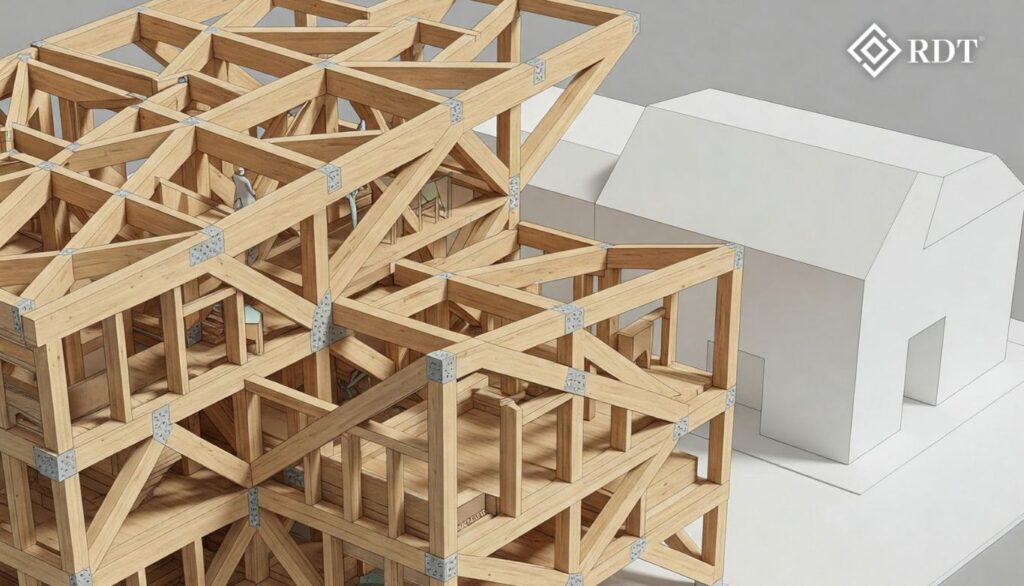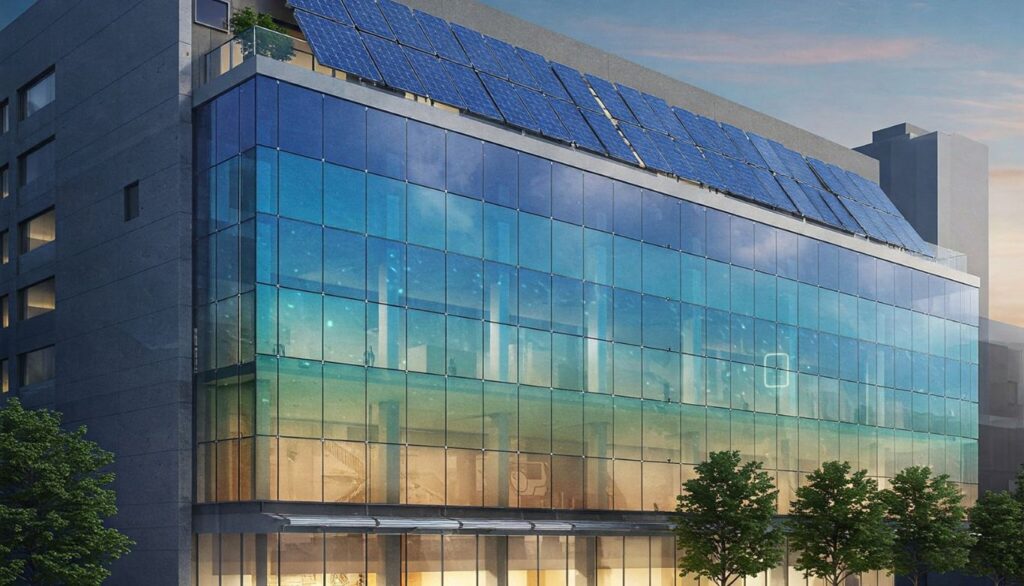Sustainability in commercial construction has shifted from a value-add to an essential practice for enterprise-level architects, contractors, and owners. With rising regulations, evolving Environmental, Social, and Governance (ESG)requirements, and advancements in material science, the approach to selecting sustainable materials has grown increasingly technical.
This blog will explore the latest trends in sustainable materials through the lens of Building Information Modeling (BIM), Life Cycle Assessment (LCA), and Digital Twin Technology.
1. AI-Enhanced Material Selection Through BIM and LCA

Selecting sustainable materials is no longer a manual process. Architects now rely on AI-powered BIM platformsintegrated with LCA software to analyze materials across their lifecycle.
AI-Driven Embodied Carbon Calculations
- 5D and 6D BIM Integration: Advanced algorithms calculate the embodied carbon of materials from extraction to decommissioning, enabling real-time decision-making.
- Monte Carlo Simulations for Uncertainty Analysis: Predictive simulations assess uncertainties in material supply chains, pricing volatility, and carbon footprint deviations.
- Comparative Scenario Analysis: Architects can run multiple material scenarios using AI algorithms to optimize sustainability goals.
Material Passporting with Digital Twins
- Real-Time Carbon Monitoring: Each material is assigned a Digital Passport within a Digital Twin, tracking carbon emissions across construction and operational phases.
- End-of-Life Assessment: Predictive models determine recyclability, repurposing options, and disposal impact, ensuring circularity in material use.
- Automated EPD Integration: BIM systems pull data from Environmental Product Declarations (EPDs) to verify material sustainability compliance.
2. Next-Gen Concrete Alternatives for Low-Carbon Construction
Concrete, responsible for nearly 8% of global CO₂ emissions, is undergoing a sustainable transformation. Architects are now utilizing AI-optimized Low-Carbon Concrete (LCC) alternatives and carbon capture technologies.
Carbon-Reducing Concrete Innovations
- CarbonCure Technology: AI-enhanced processes inject captured CO₂ into concrete, mineralizing it and reducing embodied carbon.
- Geopolymer Concrete: Produced using industrial by-products like fly ash and slag, it reduces emissions by up to 80% compared to traditional concrete.
- Supplementary Cementitious Materials (SCMs): Advanced modeling software simulates the ideal mix proportions of SCMs to reduce clinker content.
BIM-Integrated Structural Simulations
- Finite Element Analysis (FEA): Structural BIM models run FEA to predict concrete behavior, optimizing the material’s load-bearing capacity.
- Performance-Based Design (PBD): AI algorithms perform iterative simulations to ensure durability, shrinkage resistance, and seismic resilience.
- Automated Carbon Reduction Reports: BIM-linked dashboards provide real-time emissions tracking, highlighting opportunities for further carbon reduction.
3. Advanced Timber Engineering and Mass Timber Systems

Mass timber has re-emerged as a leading sustainable material for large-scale commercial projects. Innovations in Cross-Laminated Timber (CLT) and Glue-Laminated Timber (GLT) are expanding its use in skyscrapers and mixed-use developments.
Digital Twin for Timber Lifecycle Management
- Predictive Decay Modeling: AI algorithms within Digital Twins monitor timber components for moisture infiltration and microbial growth.
- Fire Performance Simulation: BIM-integrated fire modeling simulates fire propagation, ensuring compliance with local fire safety regulations.
- Structural Health Monitoring (SHM): Embedded sensors in mass timber components provide real-time data on stress, vibration, and humidity.
Carbon Sequestration Analytics
- Sequestration Models: AI tracks embodied carbon sequestration in mass timber over a building’s lifecycle.
- LCA Benchmarking: Using Digital Twin data, architects compare carbon sequestration against emissions from construction and operations.
- Circular Economy Integration: Predictive algorithms suggest material reuse strategies for future deconstruction phases.
4. Smart Glass and Photovoltaic Integration for Energy Efficiency

Smart materials are revolutionizing commercial facades. Electrochromic glass and Building-Integrated Photovoltaics (BIPVs) are now standard in net-zero energy designs.
AI-Enhanced Glass Simulation
- Thermal and Optical Modeling: BIM-integrated AI simulations predict the thermal impact of smart glass variations.
- Dynamic Glazing Optimization: Electrochromic glass reacts to external conditions, reducing cooling loads and glare while optimizing natural light.
- Solar Gain Control Algorithms: AI algorithms continuously adjust window tinting for optimal daylighting and energy savings.
BIPV and Renewable Energy Modeling
- Photovoltaic Efficiency Simulation: AI-driven simulations model solar gain angles, shadowing effects, and photovoltaic efficiency.
- Battery Storage Optimization: BIPV systems are integrated into Digital Twins to predict energy storage and load balancing.
- Grid Interaction Analysis: Using real-time data, AI algorithms determine the optimal balance between on-site generation and grid reliance.
5. AI-Powered Circular Economy and Material Reuse
Circular construction is gaining momentum, emphasizing material reuse, recycling, and resource efficiency. BIM-integrated AI algorithms identify reusable materials and predict future lifecycle stages.
Digital Twin-Enabled Circularity Management
- Material Inventory Tracking: Digital Twins maintain a live inventory of materials across commercial portfolios, predicting material availability for reuse.
- Deconstruction Simulation: AI algorithms simulate optimal deconstruction sequences, minimizing material loss and contamination.
- Blockchain for Material Provenance: Immutable blockchain records verify the lifecycle data of reused materials, ensuring quality and compliance.
Predictive Maintenance and Reuse Algorithms
- Material Degradation Modeling: AI models predict when components will reach the end of their lifecycle, triggering reuse recommendations.
- Adaptive Reuse Design Scenarios: Generative design algorithms simulate reuse scenarios, suggesting adaptive construction approaches.
Conclusion
The future of sustainable commercial construction is shaped by the seamless integration of AI-powered BIM, Digital Twins, and advanced material simulations. Enterprise-level architects leveraging these solutions can optimize material selection, reduce embodied carbon, and ensure lifecycle sustainability.





